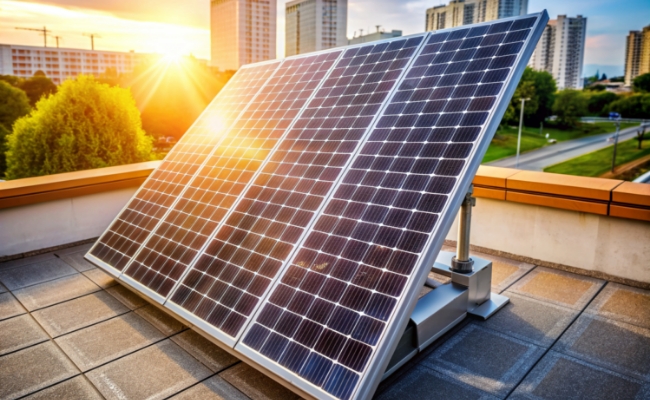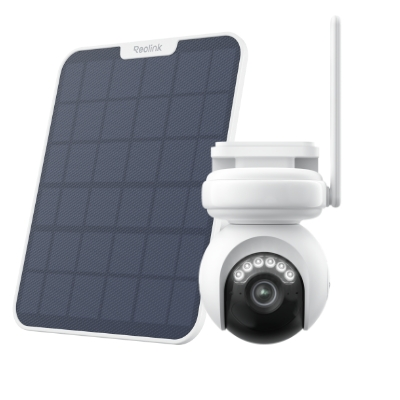Solar Panel Voltage: 2024 Ultimate Guide

Solar panel voltage is an important specification. Users must know the standard values to understand how the solar panel is working and detect issues.
In this article, we will explain what solar panel voltage is. We will explain different types of solar voltages. We will share the factors that affect solar panel voltage and the method to calculate it.
What Is Solar Panel Voltage?
When sunlight falls on the solar panel's surface, the movement of electrons starts. It creates a potential difference or voltage at both terminals of a cell. These cells are connected together in series and parallel, and a collective voltage is obtained, which is called solar panel voltage.
If you connect a voltmeter at the terminals of a solar panel under sunlight, you will be able to record open circuit voltage. It could be anywhere between 21.7V to 43.2V, depending on the type of solar panel and other factors.
Types of Solar Panel Voltage
There are three types of solar panel voltages.
Open Circuit Voltage (VOC)
The voltage that is recorded when there is no load connected to the solar panel is called Open Circuit Voltage. The circuit is open as there is no load, so there is no flow of current.
A multimeter is connected at the terminals of the solar panel directly without having a load. It is the maximum voltage that the solar panel can produce. It’s an important parameter mentioned at the back of every solar panel.
Maximum Power Voltage (VMP or VPM)
The voltage at which the solar panel produces maximum power is called Maximum Power Voltage (VMP).
In simple words, under specific conditions, there is always one voltage value that generates maximum current, which translates to maximum power. Therefore, there is no fixed value. It depends on the connected load and current solar irradiance.
Nominal Voltage
The voltage at which the solar panel is designed to operate is known as nominal voltage. It is 12V or 24V.
Different Solar Panel Voltage Chart
The voltage of a solar panel mainly depends on the solar panel type, size, cells, etc. Whether it be open circuit voltage, maximum power voltage, or nominal voltage, you will find it all in the datasheet of the manufacturer.
Generally, the nominal voltage of any solar panel is 12V or 24V. This is the voltage at which normally DC appliances operate, batteries are charged, etc. However, the nominal voltage could be 20V or 18V as well.
The open circuit voltage of solar panels ranges between 21.7V to 43.2V. You can measure it by connecting a multimeter on no load. It is also mentioned at the back of the solar panel VOC.
The maximum power voltage varies a lot because of the solar irradiance and connected load. That’s why solar chargers use algorithms like MPPT (Maximum Power Point Tracking) to find the voltage to harvest maximum energy. The voltage can be 18V to 36V.
Here is a quick overview.
Factors Influencing Solar Panel Voltage
Here are some factors that affect the solar panel voltage.
Solar Panel Efficiency
The efficiency of a solar panel decides the output voltage. If the efficiency is high, more charge will flow in the cells. It means the voltage or potential difference will also be high. If the efficiency is low, you will get a little lower voltage as some of the sunlight won’t be able to convert into solar energy.
Solar Cell Size
Solar cells have a definite size. It affects the output voltage. If the size of the cell is large, it means the cell will be able to produce more voltage at a given solar irradiance. Secondly, the number of solar cells present in a solar panel also significantly affects the voltage. The more the cells, the more will be the voltage.
Sunlight Intensity and Angle
Sunlight is responsible for voltage generation. When there is no sunlight, you will have no voltage at the terminals. But when the intensity of the sunlight is high, you will get maximum voltage. Keep in mind that solar intensity or irradiance varies at different times of the day.
Moreover, the angle at which the solar panel is placed also affects the output voltage. For maximum absorption, the angle of the sunlight should be perpendicular to the solar panel. It will generate maximum voltage.
Temperature
The ambient temperature also matters. If the temperature is too high, the efficiency of the solar panel is decreased. So, the output voltage will be lower. For high voltage, a lower temperature is needed.
How to Calculate Solar Panel Voltage?
You can easily calculate the open circuit voltage of a solar panel.
Place the panel under sunlight. Place it at a suitable angle for maximum absorption.
Connect the “+” and “-” terminals of the multimeter to the respective terminals of the solar panel. You will see the voltage on the display.
Bonus: Solar Power Security Camera Recommendation
The Reolink Altas Ultra is a great choice for a solar-powered security camera. It offers 4K Ultra HD video quality for clear and detailed footage, and its powerful 20000mAh battery supports 24-hour continuous recording for up to 4 days on a single charge. The camera also features pan-and-tilt functionality for wide-area coverage and advanced motion detection for accurate alerts.
With its solar power capabilities, the Reolink Altas Ultra provides a reliable, wireless solution for outdoor monitoring without the need for frequent charging or complicated wiring.
Industry-leading 4K Continuous Recording Battery Camera
4K UHD Continuous Recording; ColorX Night Vision; Pan & Tilt; Automatic Tracking; All Recordings Stored Locally.
FAQs
1. What is the maximum voltage of a solar panel?
The open circuit voltage is actually the maximum voltage of a solar panel. As there is no load connected, the voltage will be high. If you connect the load, the voltage will be lower than the open circuit voltage.
2. How many volts is one solar panel?
The open circuit voltage of a solar panel depends on various factors, including the type of the solar panel, number of cells, connection, etc. However, the voltage ranges between 21.7V to 43.2V.
3. How to tell if a solar panel is 12V or 24V?
The best way to know the solar panel voltage is through the manufacturer’s datasheet. You can refer to the datasheet or even check the label on the back of the solar panel. Usually, panels with 36 cells offer 12V, and 72 cells offer 24V.
4. Is a solar panel AC or DC?
Solar panels generate DC only. The sunlight generates a direct flow of current in the cells. If you want to use AC, you will need to install an inverter.
5. Does solar panel voltage change with sunlight?
Yes, the solar panel voltage varies with the solar irradiance. At maximum intensity, it will offer the maximum voltage. When there is less sunlight, the voltage will be low.
Conclusion
Solar panels generate a specific voltage under different conditions, such as loads, sunlight intensity, temperature, etc. However, the resultant voltage decides the power the panel can deliver. We have explained what solar panel voltage is and how you can calculate it. Learning about different solar panel voltages and the factors affecting them will help in better understanding and fault detection.
Search
Be in the Know
Security insights & offers right into your inbox

